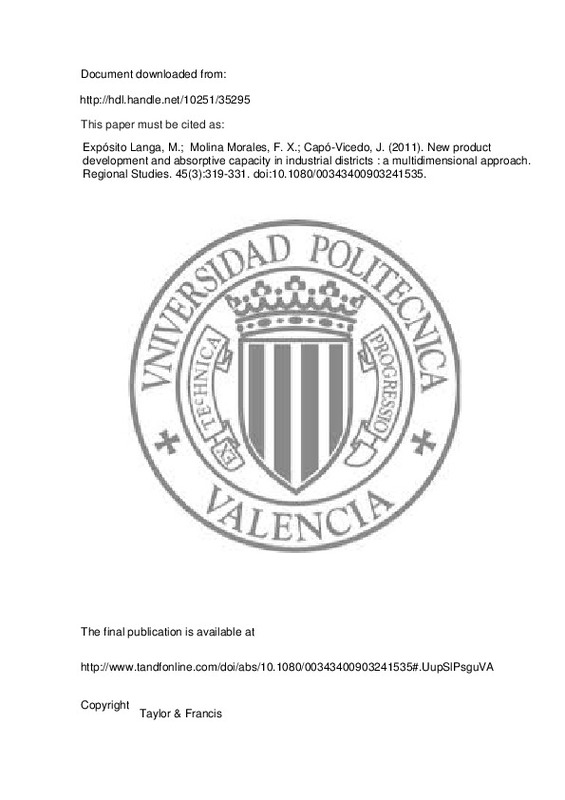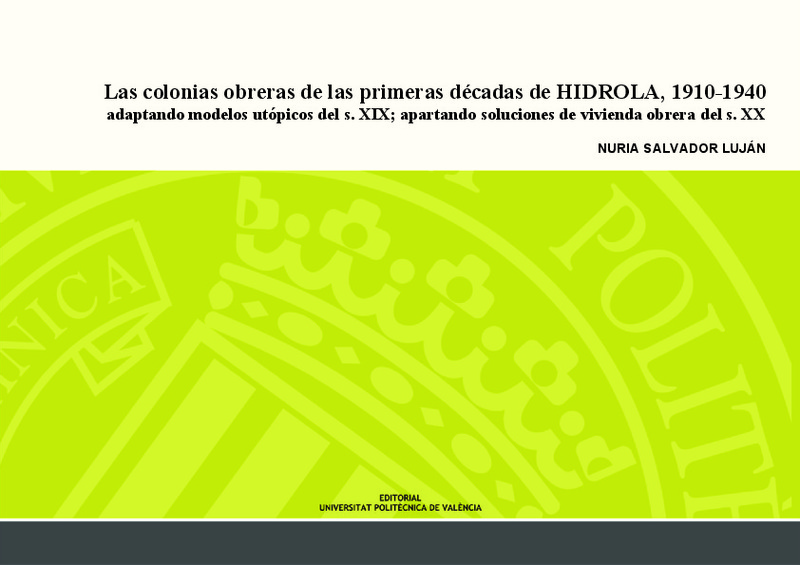Acs, Z., & Audretsch, D. (Eds.). (1991). Innovation and Technological Change. doi:10.3998/mpub.12958
Antonelli, C. (2000). Collective Knowledge Communication and Innovation: The Evidence of Technological Districts. Regional Studies, 34(6), 535-547. doi:10.1080/00343400050085657
Bathelt, H., Malmberg, A., & Maskell, P. (2004). Clusters and knowledge: local buzz, global pipelines and the process of knowledge creation. Progress in Human Geography, 28(1), 31-56. doi:10.1191/0309132504ph469oa
[+]
Acs, Z., & Audretsch, D. (Eds.). (1991). Innovation and Technological Change. doi:10.3998/mpub.12958
Antonelli, C. (2000). Collective Knowledge Communication and Innovation: The Evidence of Technological Districts. Regional Studies, 34(6), 535-547. doi:10.1080/00343400050085657
Bathelt, H., Malmberg, A., & Maskell, P. (2004). Clusters and knowledge: local buzz, global pipelines and the process of knowledge creation. Progress in Human Geography, 28(1), 31-56. doi:10.1191/0309132504ph469oa
Bellandi, M. (1996). Innovation and Change in the Marshallian Industrial District. European Planning Studies, 4(3), 357-368. doi:10.1080/09654319608720351
Belussi, F., Sammarra, A., & Rita Sedita, S. (2008). Managing Long Distance and Localized Learning in the Emilia Romagna Life Science Cluster. European Planning Studies, 16(5), 665-692. doi:10.1080/09654310802049273
Biggiero, L. (2006). Industrial and knowledge relocation strategies under the challenges of globalization and digitalization: the move of small and medium enterprises among territorial systems. Entrepreneurship & Regional Development, 18(6), 443-471. doi:10.1080/08985620600884701
Boix, R., & Galletto, V. (2009). Innovation and Industrial Districts: A First Approach to the Measurement and Determinants of the I-District Effect. Regional Studies, 43(9), 1117-1133. doi:10.1080/00343400801932342
Boschma, R. A., & ter Wal, A. L. J. (2007). Knowledge Networks and Innovative Performance in an Industrial District: The Case of a Footwear District in the South of Italy. Industry & Innovation, 14(2), 177-199. doi:10.1080/13662710701253441
Boynton, A. C., Zmud, R. W., & Jacobs, G. C. (1994). The Influence of IT Management Practice on IT Use in Large Organizations. MIS Quarterly, 18(3), 299. doi:10.2307/249620
Brown, S. L., & Eisenhardt, K. M. (1995). Product Development: Past Research, Present Findings, and Future Directions. The Academy of Management Review, 20(2), 343. doi:10.2307/258850
Caloghirou, Y., Kastelli, I., & Tsakanikas, A. (2004). Internal capabilities and external knowledge sources: complements or substitutes for innovative performance? Technovation, 24(1), 29-39. doi:10.1016/s0166-4972(02)00051-2
Chiarvesio, M., Di Maria, L. and Micelli, S. Innovation and internationalisation of Italian districts: exploitation of global competencies or transfer of local knowledge? Paper presented at the Regional Studies Association International Conference. April12–152003, Pisa, Italy.
Child, J. (1984). Organization: A Guide to Problems and Practice. doi:10.4135/9781446280348
Cockburn, I. M., & Henderson, R. M. (2003). Absorptive Capacity, Coauthoring Behavior, and the Organization of Research in Drug Discovery. The Journal of Industrial Economics, 46(2), 157-182. doi:10.1111/1467-6451.00067
Cohen, W. M., & Levinthal, D. A. (1989). Innovation and Learning: The Two Faces of R & D. The Economic Journal, 99(397), 569. doi:10.2307/2233763
Cohen, W. M., & Levinthal, D. A. (1990). Absorptive Capacity: A New Perspective on Learning and Innovation. Administrative Science Quarterly, 35(1), 128. doi:10.2307/2393553
Cohen, W. M., & Levinthal, D. A. (1994). Fortune Favors the Prepared Firm. Management Science, 40(2), 227-251. doi:10.1287/mnsc.40.2.227
Dakhli, M., & De Clercq, D. (2004). Human capital, social capital, and innovation: a multi-country study. Entrepreneurship & Regional Development, 16(2), 107-128. doi:10.1080/08985620410001677835
Deeds, D. L., Decarolis, D., & Coombs, J. (2000). Dynamic capabilities and new product development in high technology ventures. Journal of Business Venturing, 15(3), 211-229. doi:10.1016/s0883-9026(98)00013-5
Evenson, R. E., & Kislev, Y. (1973). Research and Productivity in Wheat and Maize. Journal of Political Economy, 81(6), 1309-1329. doi:10.1086/260129
Giuliani, E., & Bell, M. (2005). The micro-determinants of meso-level learning and innovation: evidence from a Chilean wine cluster. Research Policy, 34(1), 47-68. doi:10.1016/j.respol.2004.10.008
Godfrey, P. C., & Hill, C. W. L. (1995). The problem of unobservables in strategic management research. Strategic Management Journal, 16(7), 519-533. doi:10.1002/smj.4250160703
Grant, R. M. (1991). The Resource-Based Theory of Competitive Advantage: Implications for Strategy Formulation. California Management Review, 33(3), 114-135. doi:10.2307/41166664
Grant, R. M. (1996). Prospering in Dynamically-Competitive Environments: Organizational Capability as Knowledge Integration. Organization Science, 7(4), 375-387. doi:10.1287/orsc.7.4.375
Guerrieri, P., & Pietrobelli, C. (2006). Old and New Forms of Clustering and Production Networks in Changing Technological Regimes. Science, Technology and Society, 11(1), 9-38. doi:10.1177/097172180501100102
Humphrey, J., & Schmitz, H. (2002). How does insertion in global value chains affect upgrading in industrial clusters? Regional Studies, 36(9), 1017-1027. doi:10.1080/0034340022000022198
Jansen, J. J. P., Van Den Bosch, F. A. J., & Volberda, H. W. (2005). Managing Potential and Realized Absorptive Capacity: How do Organizational Antecedents Matter? Academy of Management Journal, 48(6), 999-1015. doi:10.5465/amj.2005.19573106
Lane, P. J., Koka, B. R., & Pathak, S. (2006). The Reification of Absorptive Capacity: A Critical Review and Rejuvenation of the Construct. Academy of Management Review, 31(4), 833-863. doi:10.5465/amr.2006.22527456
Lane, P. J., & Lubatkin, M. (1998). Relative absorptive capacity and interorganizational learning. Strategic Management Journal, 19(5), 461-477. doi:10.1002/(sici)1097-0266(199805)19:5<461::aid-smj953>3.0.co;2-l
Lane, P. J., Salk, J. E., & Lyles, M. A. (2001). Absorptive capacity, learning, and performance in international joint ventures. Strategic Management Journal, 22(12), 1139-1161. doi:10.1002/smj.206
Lenox, M., & King, A. (2004). Prospects for developing absorptive capacity through internal information provision. Strategic Management Journal, 25(4), 331-345. doi:10.1002/smj.379
Liu, X., & White, R. S. (1997). The relative contributions of foreign technology and domestic inputs to innovation in Chinese manufacturing industries. Technovation, 17(3), 119-125. doi:10.1016/s0166-4972(96)00090-9
Malipiero, A., Munari, F. and Sobrero, M. Focal firms as technological gatekeepers within industrial districts: knowledge creation and dissemination in the Italian packaging machinery industry. Paper presented at the Danish Research Unit for Industrial Dynamics (DRUID) Academy Winter 2005 PhD Conference. Aalborg: Aalborg University.
Mangematin, V., & Nesta, L. (1999). What kind of knowledge can a firm absorb? International Journal of Technology Management, 18(3/4), 149. doi:10.1504/ijtm.1999.002771
Maskell, P. (2001). Towards a Knowledge-based Theory of the Geographical Cluster. Industrial and Corporate Change, 10(4), 921-943. doi:10.1093/icc/10.4.921
McEvily, B., & Zaheer, A. (1999). Bridging ties: a source of firm heterogeneity in competitive capabilities. Strategic Management Journal, 20(12), 1133-1156. doi:10.1002/(sici)1097-0266(199912)20:12<1133::aid-smj74>3.0.co;2-7
Meeus, M. T. H., Oerlemans, L. A. G., & Hage, J. (2001). Patterns of Interactive Learning in a High-tech Region. Organization Studies, 22(1), 145-172. doi:10.1177/017084060102200106
Molina-Morales, F. X., & Martínez-Fernández, M. T. (2004). Factors That Identify Industrial Districts: An Application in Spanish Manufacturing Firms. Environment and Planning A: Economy and Space, 36(1), 111-126. doi:10.1068/a3618
Morrison, A. (2008). Gatekeepers of Knowledgewithin Industrial Districts: Who They Are, How They Interact. Regional Studies, 42(6), 817-835. doi:10.1080/00343400701654178
Mowery, D. C. (1983). The relationship between intrafirm and contractual forms of industrial research in American manufacturing, 1900–1940. Explorations in Economic History, 20(4), 351-374. doi:10.1016/0014-4983(83)90024-4
Mowery, D. C., Oxley, J. E., & Silverman, B. S. (1996). Strategic alliances and interfirm knowledge transfer. Strategic Management Journal, 17(S2), 77-91. doi:10.1002/smj.4250171108
Nieto, M., & Quevedo, P. (2005). Absorptive capacity, technological opportunity, knowledge spillovers, and innovative effort. Technovation, 25(10), 1141-1157. doi:10.1016/j.technovation.2004.05.001
Spender, J.-C. (1996). Making knowledge the basis of a dynamic theory of the firm. Strategic Management Journal, 17(S2), 45-62. doi:10.1002/smj.4250171106
Stock, G. N., Greis, N. P., & Fischer, W. A. (2001). Absorptive capacity and new product development. The Journal of High Technology Management Research, 12(1), 77-91. doi:10.1016/s1047-8310(00)00040-7
Szulanski, G. (1996). Exploring internal stickiness: Impediments to the transfer of best practice within the firm. Strategic Management Journal, 17(S2), 27-43. doi:10.1002/smj.4250171105
Tsai, W. (2001). KNOWLEDGE TRANSFER IN INTRAORGANIZATIONAL NETWORKS: EFFECTS OF NETWORK POSITION AND ABSORPTIVE CAPACITY ON BUSINESS UNIT INNOVATION AND PERFORMANCE. Academy of Management Journal, 44(5), 996-1004. doi:10.2307/3069443
Tu, Q., Vonderembse, M. A., Ragu-Nathan, T. S., & Sharkey, T. W. (2005). Absorptive capacity: Enhancing the assimilation of time-based manufacturing practices. Journal of Operations Management, 24(5), 692-710. doi:10.1016/j.jom.2005.05.004
Tushman, M., & Nadler, D. (1986). Organizing for Innovation. California Management Review, 28(3), 74-92. doi:10.2307/41165203
Uzzi, B. (1996). The Sources and Consequences of Embeddedness for the Economic Performance of Organizations: The Network Effect. American Sociological Review, 61(4), 674. doi:10.2307/2096399
Uzzi, B. (1997). Social Structure and Competition in Interfirm Networks: The Paradox of Embeddedness. Administrative Science Quarterly, 42(1), 35. doi:10.2307/2393808
Van den Bosch, F. A. J., Volberda, H. W., & de Boer, M. (1999). Coevolution of Firm Absorptive Capacity and Knowledge Environment: Organizational Forms and Combinative Capabilities. Organization Science, 10(5), 551-568. doi:10.1287/orsc.10.5.551
Van Waarden, F. (2001). Institutions and Innovation: The Legal Environment of Innovating Firms. Organization Studies, 22(5), 765-795. doi:10.1177/0170840601225002
Veugelers, R. (1997). Internal R & D expenditures and external technology sourcing. Research Policy, 26(3), 303-315. doi:10.1016/s0048-7333(97)00019-x
WONG, V., SHAW, V., & SHER, P. J. (1999). INTRA-FIRM LEARNING IN TECHNOLOGY TRANSFER: A STUDY OF TAIWANESE INFORMATION TECHNOLOGY FIRMS. International Journal of Innovation Management, 03(04), 427-458. doi:10.1142/s1363919699000219
Yli-Renko, H., Autio, E., & Sapienza, H. J. (2001). Social capital, knowledge acquisition, and knowledge exploitation in young technology-based firms. Strategic Management Journal, 22(6-7), 587-613. doi:10.1002/smj.183
Zahra, S. A., & George, G. (2002). Absorptive Capacity: A Review, Reconceptualization, and Extension. The Academy of Management Review, 27(2), 185. doi:10.2307/4134351
[-]







![[Cerrado]](/themes/UPV/images/candado.png)



